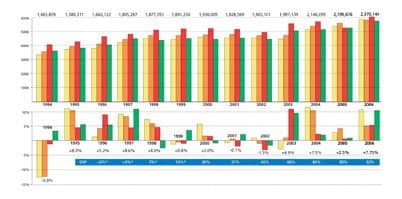Cochlear Limited (ASX: COH), an implantable hearing solutions company, announced the US Food and Drug Administration’s (FDA) clearance of the new Cochlear Osia 2 System. The Osia System is reportedly “the world’s first active osseointegrated steady-state implant (OSI),” a new category of bone conduction hearing solutions that uses digital piezoelectric stimulation to bypass damaged areas of the natural hearing system to send sound vibrations directly to the inner ear (cochlea).
The system features the new Osia OSI200 Implant that attaches to an osseointegrated BI300 Implant to send sound through the bone. The thin profile and monolithic design of the implant are said to “help to simplify surgery for the system.” On the outside, the new Osia 2 Sound Processor captures sounds and sends both the sound signal and power to the internal implant. The Osia System is available to treat hearing loss associated with an array of conditions including chronic otitis media (COM), otosclerosis and atresia/microtia. In the US, it can be used by adults and children 12 years and older with conductive hearing loss, mixed hearing loss, and single-sided sensorineural deafness (SSD). The system delivers high power and gain and has a fitting range up to 55 dB sensorineural hearing level (SNHL).1,2
The principal innovation of the Osia System lies in the heart of the implant, which contains the Piezo Power transducer made of piezoelectric material. According to Cochlear, the design is said to be “completely different than traditional bone conduction transducers,” and with no movement between the parts, it is designed to deliver long-term performance and durability when implanted. Driven by a wireless digital link, this transducer expands and contracts to create vibrations that stimulate the inner ear while optimizing transfer of power and sound quality.3 Piezoelectricity has been used for years in many products like microphones, high-end speakers, and medical equipment, but this is “the first time” it is being used in this type of hearing implant application. Cochlear notes that one of the Piezo Power’s transducer’s features is its ability to amplify high frequencies, the area of sound “most important for speech understanding.”
“At Cochlear we have been working to develop this technology for quite some time,” said Mats Dotevall, director of design and development and director of clinical affairs at Cochlear Acoustics. “We aimed to leverage Cochlear’s long history of innovation in both the cochlear implant and bone conduction implant spaces to create something entirely new. Rather than implanting a conventional electromagnetic transducer, we chose to work with piezoelectric material because of its unrivalled suitability for this type of implanted application. Lifetime testing shows Piezo Power technology provides powerful and consistent performance over time.”4
The Osia System has reportedly shown “excellent results” following a one-year, multicenter clinical investigation on a first-generation device, as well as in limited release in some clinics performing sponsored research around the world, Cochlear says. Results of the multicenter clinical investigation show a significant improvement in patients’ ability to hear in both noise and quiet compared to unaided and aided preoperative testing.5 The Osia System has also yielded a significant improvement in ratings of patients’ overall health-related quality of life, also when compared to both unaided and aided preoperative testing.5

Findings from the full one-year clinical investigation and other data on the Osia System will be presented by the research centers at the upcoming OSSEO 2019 International Congress in Miami Beach, Florida December 11-14, 2019.
“We are thrilled to introduce the new Cochlear Osia System, a first-of-its-kind innovation in implantable hearing solutions,” said Rom Mendel, President of Cochlear Acoustics. “The Osia System was developed through our efforts to listen to the recipients and clinicians who utilize our hearing implants every day. So far, we have been overwhelmed by the positive reception of the Osia System by both clinicians and patients, and it’s been incredible to see the improvement in recipients’ lives as they are able to hear better in the areas where we know they struggle.”
The Osia 2 Sound Processor features the advanced signal processing and wireless connectivity technologies available with Cochlear’s acoustic implant systems, such as Made for iPhone technology, and it is compatible with Cochlear’s True Wireless accessories. The new Osia Smart App lets the user adjust the sound processor from a compatible smartphone or Apple Watch®.* The sound processor comes with five changeable color cover options. Additionally, the Osia 2 Sound Processor is dust and moisture resistant, and with an optional Aqua+ waterproof accessory, recipients can enjoy water activities with sound.**
The Osia 2 System will soon be available in select clinics across the United States as a part of a limited release. Full commercial availability for eligible patients is expected in early 2020. Health Canada approval for the Osia 2 System is expected in early 2020. Availability in other countries is subject to regulatory approvals.
For further information on the Osia System, visit: Cochlear.us/Osia.
References
1. Osia System Datasheet. D1618102. Cochlear Limited, Sweden 2019.
2. Dotevall M. Technical Report: Available Gain in Osia vs Baha 5 Power. D1664198. Cochlear Bone Anchored Solutions AB, Sweden 2019.
3. Sunnerud H. D1575584, Design Verification Report Osia System. Cochlear Bone Anchored Solutions AB, Sweden 2019.
4. Goh J. OSI200 Implant Accelerated Life Test Reporter. D1439967. Cochlear Bone Anchored Solutions AB, Sweden 2019.
5. ClinicalTrials.gov [Internet]. Bethesda (MD): National Library of Medicine (US); 2017 March 22. Identifier NCT03086135. Clinical Performance of a New Implant System for Bone Conduction Hearing; 2019 January 31 [cited 2019 June 20]; [4 screens]. Available from: https://clinicaltrials.gov/ct2/show/NCT03086135.
* For information on sound processor and app compatibility, visit: www.cochlear.com/compatibility.
** The Osia 2 Sound Processor is IP57 rated with battery compartment excluded. The Osia 2 Sound Processor with Aqua+ is water resistant to level IP68 of the International Standard IEC60529 when used with LR44 alkaline or nickel metal hydride disposable batteries. Refer to the relevant User Guide for more information. The Osia 2 Aqua+ may not be available in all markets and is subject to regulatory approval and product availability.
Source: Cochlear
Images: Cochlear






I just signed up for two Osia implants a the Cleveland Clinic.
I have a Baja implant already can I get the new Odin and does itrequire removal of Baha